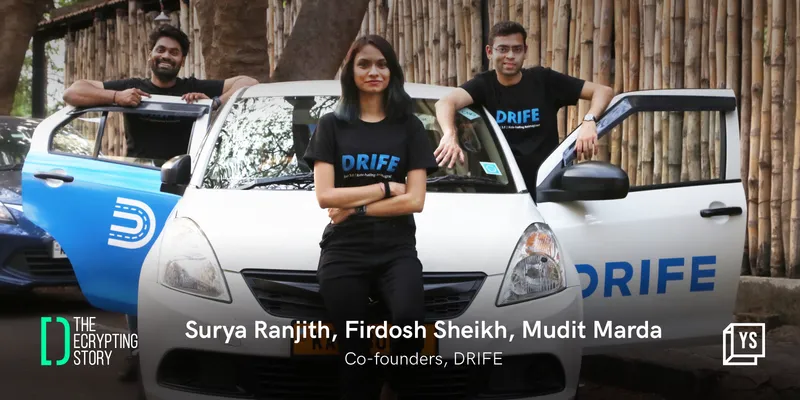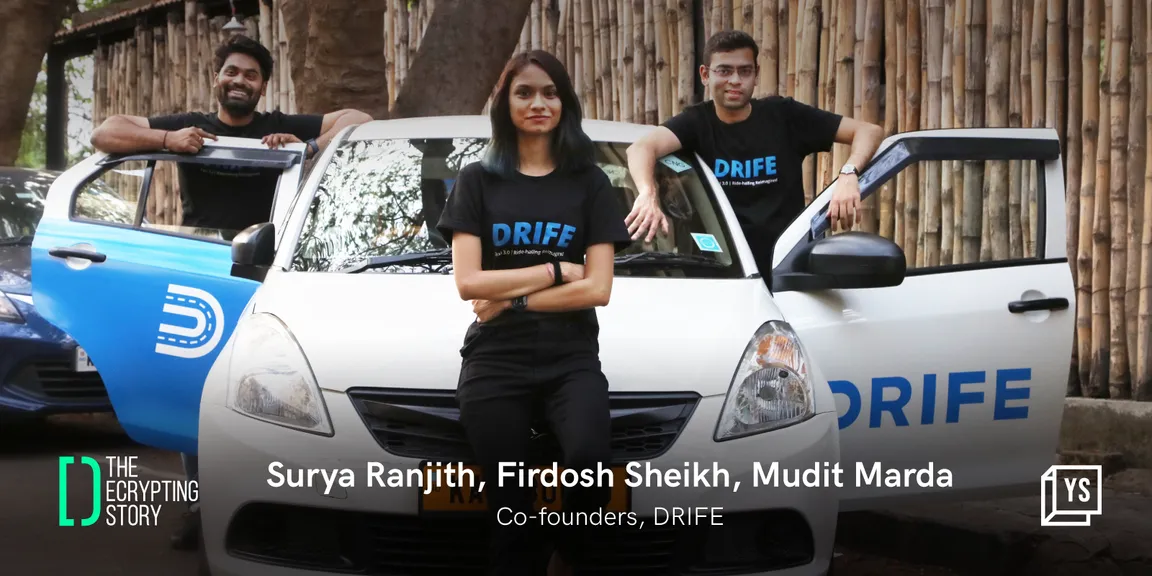Zero commission, no surge pricing: Drife takes on Ola, Uber with blockchain tech
Firdosh Sheikh, Surya Ranjith, and Mudit Marda are building a blockchain-based ride-hailing experience with no commission from drivers, market-dictated pricing, open governance, and transparency.
Lack of available cabs, ride cancellations, and price surges are making ride-hailing services increasingly difficult to use in Indian metros.
Drivers with the likes of and face a different set of challenges, such as rising fuel prices, significant and opaque commissions paid to ride-hailing partner apps, difficulties in making EMI payments, and so on.
Entrepreneur Firdosh Sheikh believes leveraging blockchain technology to tackle the existing challenges is the best way forward.
With the Bengaluru-based blockchain project (founded in 2021), Firdosh and co-founders Surya Ranjith and Mudit Marda are building a ride-hailing experience with zero commission taken from drivers, market-dictated pricing, open governance, and transparency.
“Ride-hailing companies are billion-dollar firms but their drivers still struggle to make ends meet. The most worrisome part is the existence of centralised parties manipulating the system for their profit motives. This shows how broken the system is. This is where Drife comes into the picture to fix the broken pieces,” she says in an interview with The Decrypting Story.
An early-stage project, Drife is live in Bengaluru, with the maximum concentration of its blue-and-white cabs at the Kempegowda International Airport.
Firdosh claims the startup completes around 1,000 rides per week. The rides can be booked on its Android and iOS app.
How Drife works
Like on other ride-hailing apps, a customer on Drife has to enter a pickup and drop location to find the nearest drivers. But from here on, Drife offers a lot more freedom to customers and drivers compared to Uber and Ola.
“The incumbents have a dispatch service where they choose which driver to allocate to a customer. We do not do that. We have a unique matching algorithm (based on ratings) and a search radius category that scans for all eligible drivers near the customer and shows them the user request. In addition to the base pay allocated for the ride, each driver willing to accept the ride has the option to quote a higher or lower amount for it,” Firdosh explains.
The users are then given the option to view all bids submitted by drivers and choose a driver of their preference. Drivers cannot alter a bid once submitted.
These extra steps save users from drivers calling them to ask about the destination, how much is the ride worth, etc—thus, preventing cancellations, Firdosh adds.
“Drivers know all details of a ride before accepting it and quoting their price. We are trying to be fair to both users and drivers, and let them choose the price for a trip, instead of us deciding it for them,” she says.

Drife is currently live in Bengaluru
Transparency in trip fares
The base pay is calculated based on the tariff rate set by the local government, and the time and the distance involved. The amount is not dependent on the prevailing supply-demand conditions at any given time.
“There are no hidden multipliers that increase the prices of trips at different times,” she says.
Firdosh explains with the example of a cab ride costing Rs 2,000 on Uber. Assuming commission laws are followed, she says the driver would receive 80 percent of the fare (Rs 1,600), while the rest would go to Uber.
However, several drivers continue to report that ride-hailing services deduct commissions of anywhere up to 30-40 percent. In reality, drivers may receive far less than what they expect. This has placed ride-hailing apps under the scanner of the authorities concerned about the lack of transparency surrounding the algorithms used to calculate pricing and commissions.
“When Drife calculates base pay based on distance and time, we arrive at a price of around Rs 1,000. A driver who wants to do the trip may quote Rs 1,600, and the customer accepts it,” she explains.
She claims that at Drife, there is no commission involved and the driver gets to keep the entire amount earned from the trip. Firdosh believes that at scale, with drivers making several trips per day, this model can result in the drivers earning more (and in a transparent manner) than they would on other platforms.
Drife’s revenue channels
With no commission charged from drivers, the startup earns revenue in other ways. It charges its driver-partners a nominal monthly subscription fee of Rs 2,500, which gives them access to the platform to accept, bid for, and execute rides.
“Besides this, we are working on a franchise model where people in other cities can potentially run Drife’s operations. Building tech around ride-hailing in new cities is lucrative but exhausting, hence we select the best possible parties that can run operations elsewhere. We have a revenue-sharing model in place where we receive a part of the subscription fees drivers will pay to the franchise owners,” Firdosh explains.
Unlike some blockchain apps, Drife is not a Web3 solution in search of a problem to solve. The challenges of the ride-hailing industry are well documented, and Firdosh admits any previous attempts to solve them through blockchain are not as straightforward or intuitive as they seem.
“People have tried building Uber on the blockchain, but decentralisation from day one will not magically solve any problems. Decentralisation should happen in phases. First, calculations and algorithms in the application leverage smart contracts to achieve full transparency for fair ride allocations. Then, operations become decentralised through the franchise model,” Firdosh says.
This steady approach towards slowly dissipating centralisation is often referred to as ‘progressive decentralisation’. One of its major proponents is the Ethereum scaling project Polygon, which, in fact, is the network upon which the startup is built.

Drife ecosystem and the road ahead
The Drife ecosystem features the DRF token, which can not only be traded on exchanges by users but also earned by drivers by completing various activities on the platform, and redeemed for discounts on subscription fees. The project also hand-holds drivers to stake their earned DRF tokens to avail micro loans.
“Our Bengaluru and India operations do not involve the DRF token, and our operations work seamlessly without it. We follow a strictly fiat-based model where riders and drivers transact in INR only,” Firdosh clarifies.
As it is still an early-stage project, Drife’s immediate challenge is to match demand and supply. Acquiring drivers, users, and plotting drivers in a three-kilometre radius when a customer submits a ride request is not as easy as it is made to look by multibillion-dollar valued ride-sharing firms, she shares.
In 2021, Drife raised $2.7 million in a seed (private token) round to fund its vision for decentralised ride-hailing in the Indian shared mobility market, which is expected to grow from $1 billion in 2019 to $3.95 billion by 2025, as per P&S Market Research.
“We know there are a few global projects, such as Arcade City and DAV Protocol, that want to build decentralised ride-hailing experiences. But there is nothing much built on the ground,” Firdosh says, adding, “The Web3 world is sometimes so consumed by Metaverse and gamification projects that there is hardly anyone building real-world projects.”
Edited by Kanishk Singh







